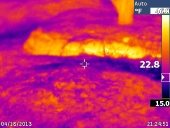Oh.
Symphylans. I have those little buggers in my potted avocado trees at home. I wish I could throw chickens at them, but all I have is my rabbit, and she prefers sweet potato. And spider plants, and avocado trees, and anything else growing out of soil, even if it's likely to make her sick. Sometimes, especially if it's likely to make her sick.
Outdoors, yeah, I think chickens or guinea fowl would do well. I'd hesitate to take this tack where you'll be growing bird-sensitive crops later, but if it weren't going to grow stuff that wild birds would come and devour, you could choose plants for the periphery that draw other predatory insects, which will draw insectivorous birds.
Apparently, tilling it into a fine seed bed when the symphylans are in the top strata of the soil will kill a lot of them. Also, reducing the amount of organic matter and compromising the soil structure, compacting it, are suggested.
I think these solutions are rudimentary at best. I think we can do better.
I would try wrapping your bed with black tarps or pond liner before the hottest, sunniest period of the year. You should be able to cook anything alive out of that bed, and keep it cooking until you can go in there with a trowel, or your hands, and verify that there are no symphylans left. You'll then be able to inoculate it with
compost extracts and fungal slurries to revivify the hugelbeet.
The main advantage of this is that you get to keep the organic matter where you put it, on purpose, in the first place. The second is that if you want to introduce a specific species of culinary or medicinal fungi, they will have much less native competition. Thirdly, you won't be compromising what is likely already superior soil structure by tilling or compacting it.
I hope this was somewhat helpful. Please let us know how you proceed, and good luck to you.
-CK
A human being should be able to change a diaper, plan an invasion, butcher a hog, conn a ship, design a building, write a sonnet, balance accounts, build a wall, set a bone, comfort the dying, take orders, give orders, cooperate, act alone, solve equations, analyze a new problem, pitch manure, program a computer, cook a tasty meal, fight efficiently, die gallantly. Specialization is for insects.
-Robert A. Heinlein

 1
1




 1
1








 1
1












 1
1

























